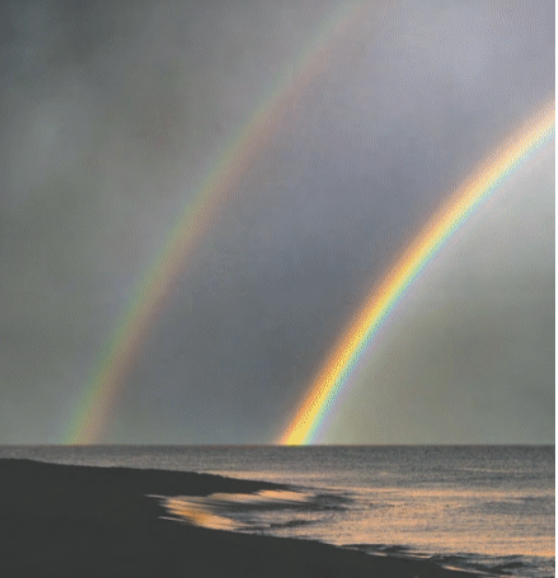
So how lucky are we? Fire Island is blessed with stunningly beautiful rainbows.
Rainbows occur when there are water drops or ice crystals in the air while sunlight shines from behind you at a low angle. Consequently, rainbows are usually seen in the west during the morning and in the east during the early evening. The most spectacular rainbows happen when the sky is dark with clouds and you’re in a position where there’s clear sky behind you, in the direction of the sun. The result is a bright colorful arc against the dark clouds. When the visibility is that good a fainter secondary rainbow is often visible outside the primary rainbow.
So how does a rainbow form? Conceptually it’s very simple: Under exactly the right conditions when there are billions of tiny water drops suspended in the air, each drop acts like a tiny little prism, and what do you get when you shine sunlight into a prism? A spread spectrum of colors … a rainbow! The detailed physics of a rainbow are complex, but basically what’s happening is that when sunlight encounters a raindrop, some of the light entering the drop is refracted (spread out) at the surface. When this light hits the back of the raindrop, it bounces those colors back to your eye.
The same thing happens in high cirrus clouds, which at 30 to 40 thousand feet are made of ice crystals. Each crystal also acts like a tiny prism, producing rainbows high overhead. Rainbows can also form in the spray of waterfalls, waves or fountains (called spray bows). Rarely, a moonbow (lunar rainbow) can be seen on strongly moonlit nights. They also contain a full spectrum of colors, but because humans have poor low-light color vision, moonbows are usually perceived as white.
Of course, a rainbow is not located at a specific distance from you, nor is it an object that can be physically approached. Even if you see another person who seems to be under the rainbow, that person sees a different rainbow, further away but at the same angle as you see it.
Rainbows display a continuous spectrum of colors. The distinct banding is a consequence of the human color vision system. Of the colors seen by the human eye, the most described sequence is red, orange, yellow, green, cyan, blue and violet. Secondary rainbows are fainter but contain the same colors in reverse order.
It’s challenging to photograph the complete semi-circle of a rainbow in one shot because to capturing the entire thing requires a very wide-angle lens covering 84°. Software for combining images into a panorama allows images of the entire arc to be created from a set of overlapping frames, but I leave that sort of thing to others. I’m very old school and I don’t use image manipulation software or digital software filters. I limit my adjustments to in-camera techniques such as underexposure (to make colors as saturated in the photograph as to the unaided eye when viewing the original scene) and some of the techniques that would be used in a traditional dark-room, such as cropping, burning or dodging.





























